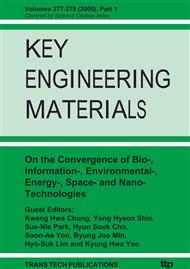p.397
p.403
p.410
p.418
p.424
p.431
p.438
p.445
p.450
Study of Design Parameters for Semiconductor/FPD Cleanroom Focused on Airborne Contamination
Abstract:
Unidirectional airflow cleanroom was designed to ideally control the flow in order to overcome airborne contamination problems, and that design has not changed much over the past twenty years. However, in reality, it didn’t work as expected. Thus, airborne contamination problems in semiconductor and flat panel display industries still existed even if entire fabrication was processed in unidirectional cleanrooms. Eventually, flow-based re-evaluation of existing unidirectional cleanroom design became inevitable. In this study, we performed fluid dynamics simulations of unidirectional cleanroom at various dimensions, and interpreted the results for further steps of cleanroom designs, such as, inlet/outlet ducts, perforated floors, and equipment arrangement. Furthermore, we developed the mathematical model that interprets the airflow inclination at various cleanroom dimensions into a unified representation to provide designers with concepts for flow-based integration of cleanroom layout. The predicted angle/location of the maximum flow inclination by our mathematical model in terms of fundamental design parameters agreed well with the computational fluid dynamics simulation results and with the expected trends.
Info:
Periodical:
Pages:
424-430
Citation:
Online since:
January 2005
Authors:
Price:
Сopyright:
© 2005 Trans Tech Publications Ltd. All Rights Reserved
Share:
Citation:


